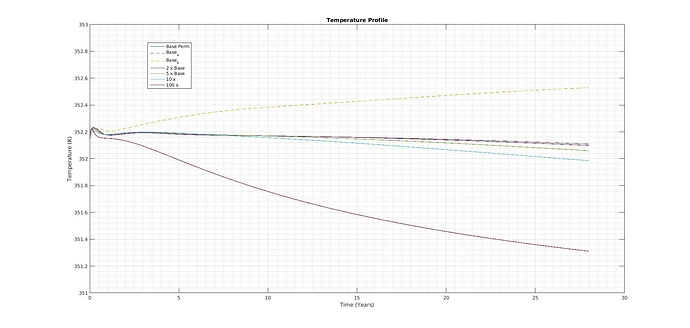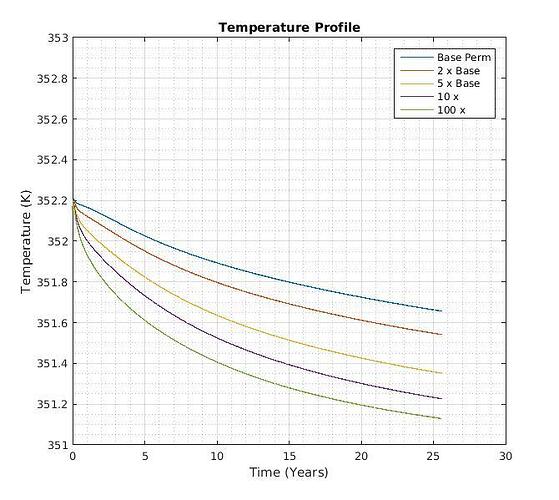Hi Nori,
Just seeing your last comment.
I ran the simulations last night with your initial suggestion of settign
the $STORAGE to zero and I got some more reasonable results (picture
attached) .
The temperature decrease is still very small and it could very well be
due to the MFP file as you suggested. I will make some adjustments.
Thanks,
Ariel
On Wednesday, June 1, 2016 at 11:49:55 PM UTC+2, Norihiro Watanabe wrote:
Some more comments:
- $SPECIFIC_HEAT_CONDUCTIVITY in MFP should be corrected to
$HEAT_CONDUCTIVITY.
- Always output element velocity (see below) instead of node
velocity because the output of node velocity is wrong if your
problem includes fractures.
$NOD_VALUES
PRESSURE1
TEMPERATURE1
$ELE_VALUES
VELOCITY1_X
Best,
nori
On 01/06/16 23:40, Ariel Thomas wrote:
> Ohhh ok, I will try this.
>
> Thanks again!
>
> Ariel
>
> On Wednesday, June 1, 2016 at 10:47:33 PM UTC+2, Norihiro Watanabe > wrote:
>
> Ariel, can you try with setting zero or 1e-10 to $STORAGE in MMP?
> 1e-5 is too large. The storage in LIQUID_FLOW is actually the
> compressibility of media and is normally in a range of 1e-9 -
1e-11,
> e.g. water compressibility is 4e-10. Setting zero to the storage
> means you calculate steady flow.
>
> nori
>
> On 01/06/16 21:38, Ariel Thomas wrote:
> > I tried to attached a zip file but I kept getting an error
and I
> had to
> > change the extension of the .msp file to .txt
> >
> > On Wednesday, June 1, 2016 at 9:22:07 PM UTC+2, Norihiro > Watanabe > > wrote:
> >
> > Ariel, can you send me the input files?
> >
> > nori
> >
> > On 01/06/16 21:18, Ariel Thomas wrote:
> > > Hi Nori,
> > >
> > > I was able to make good progress with the geothermal
doublet
> > simulation
> > > so far, thanks for your input, I appreciate it.
> > >
> > > I have run a few simulations in a reservoir with one
fracture
> > connecting
> > > two injection points, the coupled fluid flow and heat
transport
> > problem
> > > seems to working now, however, the resulting temperature
> profile
> > seems
> > > very unrealistic.
> > >
> > > I am simulating using an injection/production rate of
75m3/h
> over a
> > > period of 30 years. I inject water at 50 deg C and the
> resultant cold
> > > water front tells me that the coupled process is working.
> However, my
> > > production temperature should drop by a few degrees after
> > producing for
> > > 30 years but this is not the case, the production
temperature
> > stays more
> > > or less constant.
> > >
> > > I have tried adjusting the .num file but with no
reasonably
> different
> > > outcome. I also ran some simulations where I increased
the
> > permeability
> > > (2X, 5X, 10X..) of the fracture and I saw a bit of a
production
> > > temperature decrease in those cases but even for 100X
my base
> > > permeability the temperature decrease was just about 1
deg. I
> > attached a
> > > plot showing a few of the temperature profiles for the
Base
> > Permeability
> > > case as well as some of the variations. In one case the
> > temperature even
> > > increased but here I did not use the mass lumping
method and
> > > Streamline-Upwind/Petrov-Galerkin (SUPG) method.
> > >
> > > I suspect maybe I am not including the correct
combination of
> > parameters
> > > in my .mmp file to properly simulate heat transfer
between the
> > fluid and
> > > the matrix or something like that. I would greatly
> appreciate any
> > advice
> > > that you may be able to give with regards to this
problem. I
> have
> > tried
> > > switching around a lot of parameters but I can't seem
to get
> a very
> > > realistic output.
> > >
> > > I have also attached my input files if that helps.
> > >
> > > Thanks,
> > > Ariel
> > >
> > > On Tuesday, May 17, 2016 at 8:29:13 AM UTC+2, Norihiro > Watanabe > > > wrote:
> > >
> > > Hi Ariel,
> > >
> > > > 1. I would like to inject water at a constant
> temperate, I
> > > implemented
> > > > this as a temperature boundary condition on the
same
> > injection pt.
> > > So at
> > > > the same point, I have set a CONSTANT_NEUMANN
for liquid
> > flow and
> > > > CONSTANT value for temperature. Does OGS couple
this
> > temperature
> > > > condition with the water also being injected at
that
> point or
> > > should I
> > > > set a constant temperature at this point as a
source
> term as
> > well?
> > >
> > > No, you shouldn't do it. Your setting (the injection
> flow rate
> > as a
> > > source term for liquid flow, the injection
temperature as
> > Dirichlet BC
> > > for heat transport) is fine.
> > >
> > > > 2. Have I included the correct functions in my .num
> file to
> > > successfully
> > > > implement a coupled liquid flow and heat transport
> problem.
> > >
> > > $OVERALL_COUPLING should be given before #NUMERICS as
> below. and
> > > $COUPLED_PROCESS is not needed in this case. The
keyword is
> > useful when
> > > you have more than two processes and want to make
two of
> them
> > coupled.
> > >
> > > $OVERALL_COUPLING
> > > ;min_iter -- max_iter
> > > 1 3
> > > #NUMERICS
> > > $PCS_TYPE
> > > LIQUID_FLOW
> > > ...
> > > #NUMERICS
> > > $PCS_TYPE
> > > HEAT_TRANSPORT
> > > ...
> > > #STOP
> > >
> > > Though I'm not sure which tutorials you have already
> read, in
> > general I
> > > recommend the followings to get an introduction about
> geothermal
> > > modeling with OGS:
> > >
Geoenergy Modeling I
<https://docs.opengeosys.org/books/geoenergy-modeling-i>
> <Geoenergy Modeling I
<https://docs.opengeosys.org/books/geoenergy-modeling-i>>
> > <Geoenergy Modeling I
<https://docs.opengeosys.org/books/geoenergy-modeling-i>
> <Geoenergy Modeling I
<https://docs.opengeosys.org/books/geoenergy-modeling-i>>>
> > >
<Geoenergy Modeling I
<https://docs.opengeosys.org/books/geoenergy-modeling-i>
> <Geoenergy Modeling I
<https://docs.opengeosys.org/books/geoenergy-modeling-i>>
> > <Geoenergy Modeling I
<https://docs.opengeosys.org/books/geoenergy-modeling-i>
> <Geoenergy Modeling I
<https://docs.opengeosys.org/books/geoenergy-modeling-i>>>>
> > >
> >
>
https://github.com/norihiro-w/ogs5-egs/raw/gh-pages/docs/Tutorial_DF.pdf
<https://github.com/norihiro-w/ogs5-egs/raw/gh-pages/docs/Tutorial_DF.pdf>
>
<https://github.com/norihiro-w/ogs5-egs/raw/gh-pages/docs/Tutorial_DF.pdf
<https://github.com/norihiro-w/ogs5-egs/raw/gh-pages/docs/Tutorial_DF.pdf>>
>
> >
>
<https://github.com/norihiro-w/ogs5-egs/raw/gh-pages/docs/Tutorial_DF.pdf
<https://github.com/norihiro-w/ogs5-egs/raw/gh-pages/docs/Tutorial_DF.pdf>
>
<https://github.com/norihiro-w/ogs5-egs/raw/gh-pages/docs/Tutorial_DF.pdf
<https://github.com/norihiro-w/ogs5-egs/raw/gh-pages/docs/Tutorial_DF.pdf>>>
>
> >
> > >
> >
>
<https://github.com/norihiro-w/ogs5-egs/raw/gh-pages/docs/Tutorial_DF.pdf
<https://github.com/norihiro-w/ogs5-egs/raw/gh-pages/docs/Tutorial_DF.pdf>
>
<https://github.com/norihiro-w/ogs5-egs/raw/gh-pages/docs/Tutorial_DF.pdf
<https://github.com/norihiro-w/ogs5-egs/raw/gh-pages/docs/Tutorial_DF.pdf>>
>
> >
>
<https://github.com/norihiro-w/ogs5-egs/raw/gh-pages/docs/Tutorial_DF.pdf
<https://github.com/norihiro-w/ogs5-egs/raw/gh-pages/docs/Tutorial_DF.pdf>
>
<https://github.com/norihiro-w/ogs5-egs/raw/gh-pages/docs/Tutorial_DF.pdf
<https://github.com/norihiro-w/ogs5-egs/raw/gh-pages/docs/Tutorial_DF.pdf>>>>
>
> >
> > >
> > > Best,
> > > Nori
> > >
> > > --
> > > Norihiro Watanabe, Dr.-Ing.
> > > Department of Environmental Informatics (ENVINF)
> > > Wissenschaftler
> > >
> > > Helmholtz-Zentrum für Umweltforschung GmbH - UFZ
> > > Helmholtz Centre for Environmental Research GmbH -
UFZ
> > > Permoserstraße 15 / 04318 Leipzig / Germany
> > >
> > > norihiro...@ufz.de <javascript:> / http://www.ufz.de
> > > Telefon +49 341 235 1806
> > >
> > > Sitz der Gesellschaft: Leipzig
> > > Registergericht: Amtsgericht Leipzig, Handelsregister
> Nr. B 4703
> > > Vorsitzender des Aufsichtsrats: MinDirig Wilfried
Kraus
> > > Wissenschaftlicher Geschäftsführer: Prof. Dr.
Georg Teutsch
> > > Administrativer Geschäftsführer: Dr. Heike Graßmann
> > >
> > > --
> > > You received this message because you are subscribed
to the
> Google
> > > Groups "ogs-users" group.
> > > To unsubscribe from this group and stop receiving emails
> from it,
> > send
> > > an email to ogs-users+...@googlegroups.com <javascript:>
> > > <mailto:ogs-users+...@googlegroups.com <javascript:>>.
> > > For more options, visit
https://groups.google.com/d/optout
> <https://groups.google.com/d/optout
<https://groups.google.com/d/optout>>
> > <https://groups.google.com/d/optout
<https://groups.google.com/d/optout>
> <https://groups.google.com/d/optout
<https://groups.google.com/d/optout>>>\.
> >
> > --
> > Norihiro Watanabe, Dr.-Ing.
> > Department of Environmental Informatics
> >
> > Helmholtz-Zentrum für Umweltforschung GmbH - UFZ
> > Helmholtz Centre for Environmental Research GmbH - UFZ
> > Permoserstraße 15 / 04318 Leipzig / Germany
> > Telefon +49 341 235 1806
> > norihiro...@ufz.de <javascript:> / www.ufz.de
<http://www.ufz.de>
> <http://www.ufz.de> <http://www.ufz.de>
> >
> > Sitz der Gesellschaft: Leipzig
> > Registergericht: Amtsgericht Leipzig, Handelsregister
Nr. B 4703
> > Vorsitzender des Aufsichtsrats: MinDirig Wilfried Kraus
> > Wissenschaftlicher Geschäftsführer: Prof. Dr. Georg Teutsch
> > Administrativer Geschäftsführer: N.N.
> >
> > --
> > You received this message because you are subscribed to the
Google
> > Groups "ogs-users" group.
> > To unsubscribe from this group and stop receiving emails
from it,
> send
> > an email to ogs-users+...@googlegroups.com <javascript:>
> > <mailto:ogs-users+...@googlegroups.com <javascript:>>.
> > For more options, visit https://groups.google.com/d/optout
<https://groups.google.com/d/optout>
> <https://groups.google.com/d/optout
<https://groups.google.com/d/optout>>\.
>
> --
> Norihiro Watanabe, Dr.-Ing.
> Department of Environmental Informatics
>
> Helmholtz-Zentrum für Umweltforschung GmbH - UFZ
> Helmholtz Centre for Environmental Research GmbH - UFZ
> Permoserstraße 15 / 04318 Leipzig / Germany
> Telefon +49 341 235 1806
> norihiro...@ufz.de <javascript:> / www.ufz.de
<http://www.ufz.de> <http://www.ufz.de>
>
> Sitz der Gesellschaft: Leipzig
> Registergericht: Amtsgericht Leipzig, Handelsregister Nr. B 4703
> Vorsitzender des Aufsichtsrats: MinDirig Wilfried Kraus
> Wissenschaftlicher Geschäftsführer: Prof. Dr. Georg Teutsch
> Administrativer Geschäftsführer: N.N.
>
> --
> You received this message because you are subscribed to the Google
> Groups "ogs-users" group.
> To unsubscribe from this group and stop receiving emails from it,
send
> an email to ogs-users+...@googlegroups.com <javascript:>
> <mailto:ogs-users+...@googlegroups.com <javascript:>>.
> For more options, visit https://groups.google.com/d/optout
<https://groups.google.com/d/optout>\.
--
Norihiro Watanabe, Dr.-Ing.
Department of Environmental Informatics
Helmholtz-Zentrum für Umweltforschung GmbH - UFZ
Helmholtz Centre for Environmental Research GmbH - UFZ
Permoserstraße 15 / 04318 Leipzig / Germany
Telefon +49 341 235 1806
norihiro...@ufz.de <javascript:> / www.ufz.de <http://www.ufz.de>
Sitz der Gesellschaft: Leipzig
Registergericht: Amtsgericht Leipzig, Handelsregister Nr. B 4703
Vorsitzender des Aufsichtsrats: MinDirig Wilfried Kraus
Wissenschaftlicher Geschäftsführer: Prof. Dr. Georg Teutsch
Administrativer Geschäftsführer: N.N.
--
You received this message because you are subscribed to the Google
Groups "ogs-users" group.
To unsubscribe from this group and stop receiving emails from it, send
an email to [email protected]
<mailto:[email protected]>.
For more options, visit https://groups.google.com/d/optout\.

